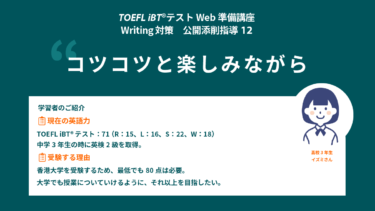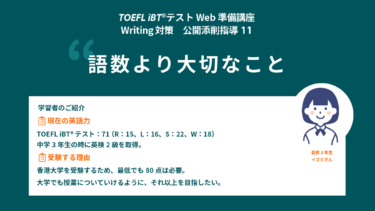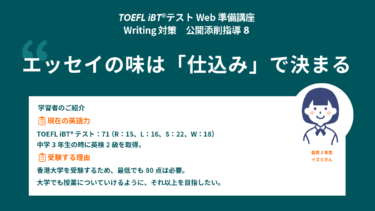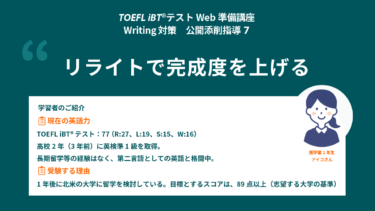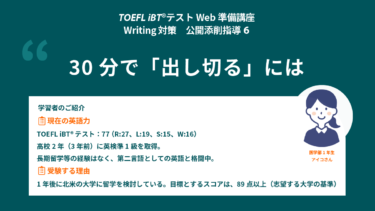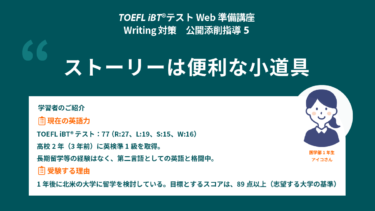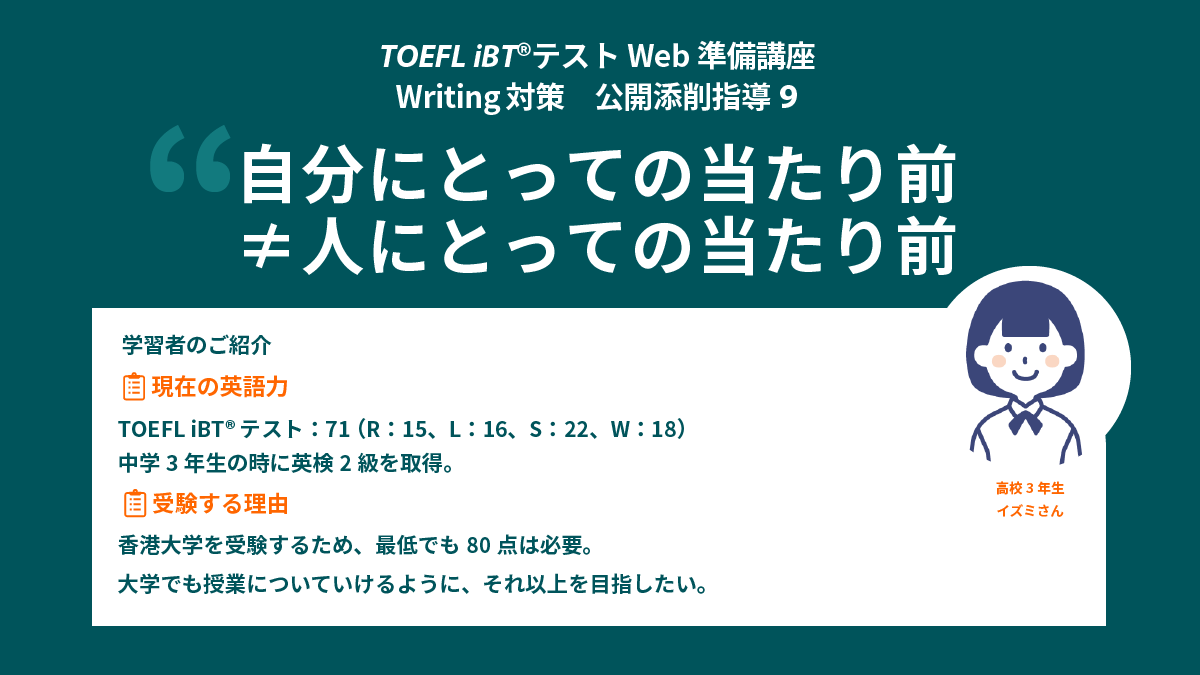
みなさん、こんにちは。TOEFL iBT®テストWeb準備講座を担当するETS公認トレーナーの横川綾子(よこがわあやこ)です。前回から新しいモデル学習者・イズミさんをお迎えし、ブレーンストーミングから校正まで段階を踏んでエッセイを仕上げていく過程を、読者のみなさんと追体験しています。春から新生活を始める人も多いと思いますが、TOEFL®テスト対策は自分のペースで着々と進めてくださいね。

イズミさん
現在の英語力
中学3年生の時に英検2級を取得。進研模試やセンター試験の英語の偏差値は75以上、リスニングは80以上。アメリカの高校に2014年9月から通っている。初めて受けた2015年1月のTOEFL iBTテストの結果は71点(R:15、L:16、S:22、W:18)。
TOEFL iBT®テストを受験する理由
香港大学を受験するため、最低でも80点は必要。大学でも授業についていけるように、それ以上を目指したい。
TOEFL iBT®テストの学習で困っている点や悩んでいる点
独学なので購入したテキストを使い格闘している。短時間でスコアを上げたいので、最低でも押さえておくエッセイのポイントや幼稚にならない書き方が知りたい。
留学したい理由
大学で英語を学ぶのではなく、大学で英語を使って、つまり英語を手段として専門的な内容を学びたい。アジアの最高レベルと言われている大学で、アジアと世界のつながりを学びたいと思っている。
英語学習全般での課題や質問
ボキャブラリーが少なく、単語を覚えるのが苦手。スピーキングでは、緊張してしまい、正しく整理された文法を使って、決められた時間で話すことが苦手。
イズミさんへの次の課題は、最初の課題で出した3つのアイディアを具体例・経験談・エピソードで膨らませ、複数のセンテンスから成る3つのパラグラフへ発展させることでした。
エッセイのテーマ
Do you agree or disagree with the following statement?
Face-to-face communication is better than other types of communication, such as letters, e-mail, or telephone calls.
Use specific reasons and examples to support your answer.
以下の主張に賛成ですか、反対ですか。
対面でのコミュニケーションは、手紙、Eメール、電話といった他のコミュニケーション方法よりも優れている。
自分の意見の根拠となる特定の理由と例を用いなさい。
前回課題より
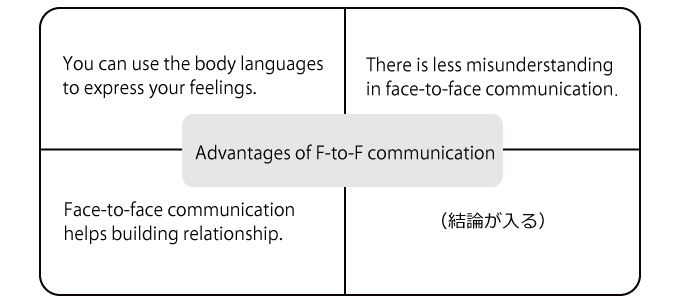
課題1
2. 3. 4. を詳しく説明するための、具体例・経験談・エピソード(Detail)を2つ以上英語で書いてください。
<イズミさんのアイディア>
2. You can use the body languages to express your feelings
Detail 1 : Using body languages is an easier way of expressing feelings than spoken language.
Detail 2 : Body languages can emphasize your feelings.
3. There is less misunderstanding in face-to-face communication.
Detail 1 : If you don’t understand what a person is talking about, you can ask the person to say it again and make sure you get it.
Detail 2 : Fast response. You can get more information from the person.
4. Face-to-face communication helps building relationship.
Detail 1 : You can know the personality of the person.
Detail 2 : You can make memories with them.
横川先生からコメント その1
前回課題で挙げた利点は抽象的なので、より詳細な情報(具体例・経験談・エピソード)を読み手に提供し、3つの利点に説得力を持たせていきます。エッセイのテーマにFace-to-face communication is better…とありますが、対面コミュニケーションが他の手段より「どのような点において」優れている/劣っていると主張するかは、書き手に任されています。2つの事柄の優劣を考える際、比較するポイントを限定する(例:忙しい人同士が連絡を取り合う場合、信頼関係を構築したい場合)と発想が広がります。
イズミさんが書いた6つのDetailは文法・語法のエラーはなく明快な内容ですが、まだ抽象度が高い印象です。これらのDetailをパラグラフに発展させる際は、誰もが理解できる比喩や情景描写などを通じ、読み手に「なるほどね」と思わせる工夫が必要です。また論理の飛躍も避ける必要があります。自分にとっては明白で当たり前だと思うことも、持論の前提や論拠としてすべて書いていきましょう。
課題2
2. You can use the body languages to express your feelings. のパラグラフ
First, we can use body languages only in face-to-face communication. Using body languages is to express our feelings. In my opinion, using body languages is an easier way of expressing our feelings than spoken language. When we feel happy and comfortable, we will smile automatically. We don’t need to use any words to explain. Also, body languages can emphasize your feelings. We are always using body languages to emphasize how happy or sad we are. Last week, my friend told me that she passed the entrance exam of college, and I was very happy to hear that. I literally jumped up and gave her a big hug. It may be same meaning with saying “congratulation!” to her. But the body languages are emphasizing how happy I was. It made her happier than just saying congratulation. The natural body languages help a lot to express your feelings.
3. There is less misunderstanding in face-to-face communication. のパラグラフ
Second, there is less misunderstanding in face-to-face communication. During face-to-face communication, we give fast response on the other hands we get fast response. Fast response makes the conversation smooth and less misunderstanding. While you are listening to someone talk, and you don’t get the meaning. You can ask the person in front of you. Moreover you can ask the person to explain again for using other simple words and make sure you understand the meaning. If you are interested in the topic, you can get more information from the person immediately. Face-to-face communication can make sure if you understand the topic or not and get more information about that.
4. Face-to-face communication helps building relationship. のパラグラフ
Third, face-to-face communication helps building relationship. In my experience, after talking to someone, I got to know the personality of the person. When you know the personality, building relationship is much easier. Face-to-face communication means that you are in the same space with someone and you have an eye contact with him or her. You share all the things like feelings, atmosphere, time, weather and the happening together. It’s like making a memory with someone. I can say making memories is as same as building good relationship. Face-to-face communication is one of the ways to build deep relationship.
横川先生からコメント その2
イズミさんの書いた3つのパラグラフには意味の理解を妨げる文法・語法のミスはほぼありませんし、センテンス同士のつながりもスムーズです。言語面のアドバイスは「パラグラフの添削例」に譲り、ここでは内容についてコメントします。
まず利点2.のパラグラフでは、対面コミュニケーションにおいては感情表現が容易になることが明快に説明されていますが、「感情表現の容易さはコミュニケーション手段の優劣を決める重要な要因(よって感情表現がしやすい対面コミュニケーションは他の手段より優れている)」というロジックがあるとよかったと思います。「感情表現=重要」という書き手の前提を読み手に示したうえで主張を展開すると、パラグラフ全体が活きてきます。
利点3.のパラグラフは読み手をしっかりと持論に導いています。対面コミュニケーションが「どのような点において」優れているかが、聞き手・話し手の両面からわかりやすく説明されています。
利点4.のパラグラフもよく展開されていますが、「コミュニケーションの目的の1つは人間関係の構築である」という1文がTopic sentence付近にあると、論旨がよりクリアに浮き上がったのではないかと思います。
パラグラフの添削例
First, we can use body languages only in face-to-face communication. Using body languages is [It] to express our feelings. In my opinion, using body languages is an easier [easy] way of expressing [to express] our feelings than spoken language [quickly]. When we feel happy and comfortable, we will smile automatically. We don’t need to use any words to explain. Also, body languages can emphasize your feelings. We are always using body languages [it] to emphasize [show] how happy or sad we are. Last week, my friend told me that she passed the [her] college entrance exam of college, and. I was very happy to hear that. I literally jumped up and gave her a big hug. It [This] may be [the] same meaning with [as] saying “congratulation[s!]” to her. [, but] But the body languages are emphasizing [it showed] how happy I was. It [and also] made her happier than just [by] saying “congratulation[s!]” The natural body languages [of the body really] help[s] a lot to express your feelings.
Second, there is less misunderstanding in face-to-face communication. During face-to-face communication, we give [respond and are replied to] fast response on the other hands we get fast response. Fast response makes the conversation [go] smooth[ly] and [there is] less misunderstanding. While you are listening to someone talk, and you don’t get the meaning. [If you don’t get the meaning of something,] Y[y]ou can ask the person in front of you [right away]. Moreover[,] you can ask the person to explain again for using [and use] other[,] more simple words and [to] make sure you understand the meaning. If you are interested in the topic, you can [also] get more information from the person immediately. Face-to-face communication can [is the best way to] make sure if you understand the topic or not and get more information about that.
Third, face-to-face communication helps [to] building relationship[s]. In my experience, after talking to someone, I got [get] to know the personality of the person. When [This makes] you know the personality, building [a] relationship [with them] is much easier. Face-to-face communication [not only] means that you are in the same space with someone and you have an [are in] eye contact with him or her [them]. [, but] Y[y]ou [are] share[ing] all the [same] things like feelings, atmosphere, time, weather and the happening [experience] together. It’s like making a memory with someone. I can say[,] making a memories[y] is as [the] same as building [a] good relationship. [It is clear that] F[f]ace-to-face communication is one of the [best] ways to build deep relationship[s].
英文校正協力:Paul Strifler
いかがでしたか。エッセイを書くときは「自分にとっての当たり前は人にとっての当たり前ではない」と自分に言い聞かせ、順を追ってすべてを説明しましょう。三段論法の説明でよく使われるのが【大前提】人間は死ぬ 【小前提】ソクラテスは人間である 【結論】ソクラテスは死ぬ という例ですが、論理展開おいて【小前提】が抜け落ちると途端に説得力がなくなります。エッセイを書くときは論理の飛躍がないか、常にモニター機能をONにできるといいですね。では次回お会いしましょう。

横川綾子先生
明治大学 国際連携機構 特任教授
ETS Authorized Propell® Facilitator
ETS TOEFL ITP® Teacher Development Workshop Facilitator
上記は掲載時の情報です。予めご了承ください。最新情報は関連のWebページよりご確認ください。
学習サポート・関連情報
★テスト受験までの8週間サポート★

初めてTOEFL iBT®テストを受験される方のうち、次の対象者には週1回✖️8週間 の受験支援メール配信とTOEFL iBT® Test Prep Plannerの無料配送を行っています。
対策塾などに通わず、独学で勉強されている皆さん、「TOEFL®テストの勉強は孤独・心配・不安…」と感じていませんか?
ETS Japanは、8週間サポートを通じて、学習計画の立て方や、勉強に必要な情報の探し方をお手伝いします。目標スコア獲得に向けて受験日まで一緒に進んでいきましょう!
★公式教材を利用して目標スコアを目指そう★

目標スコア別に公式教材を利用した学習法を教材ショップのスタッフがご提案。学習の目安や各教材ごとの学習方法など、ぜひ参考にしてください。

Performance Descriptors for the TOEFL iBT® test
各セクションは0~30のスコアで評価され、そのスコアに応じて4または5段階のレベルに分けられます。このレベルはTOEFL iBT®テストにおけるCEFR levelを反映しています。
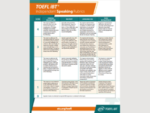
TOEFL iBT®テスト スコアガイド(Speaking)
Speakingセクションの採点基準です。上記の「Performance Descriptors for the TOEFL iBT®test」と併せてご活用ください。
SpeakingはETSが公表しているスコア基準表に沿って採点されます。採点基準はIndependent Task用・Integrated Task用にそれぞれ作成されており、Delivery(話し方)/Language Use(語彙の使い方)/Topic Development(トピックの展開)の大きく3つのポイントに分かれています。
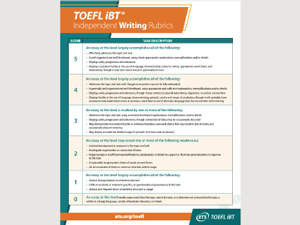
TOEFL iBT®テスト スコアガイド(Writing)
Writingセクションの採点基準です。上記の「Performance Descriptors for the TOEFL iBT® test」と併せてご活用ください。
Writingに関してもETSが公表しているスコア基準表に沿って採点されます。採点基準はIndependent Task用・Integrated Task用にそれぞれ作成されています。

英語圏の大学・機関だけでなく、世界の大学・機関で、公式スコアとして留学や就活などに活用されています。コンピュータ上で受験し、スピーキングは回答音声をマイクを通して録音、ライティングはタイピングで回答します。

自宅受験TOEFL® Essentials™テスト
2021年から自宅受験型の新しいテストとしてリリースされました。約90分の試験時間、短い即答式タスクが特徴のアダプティブ方式の導入されています。公式スコアとして留学や就活などにご利用いただけます。

TOEFL ITP®テストプログラムは、学校・企業等でご実施いただける団体向けTOEFL®テストプログラムです。団体の都合に合わせて試験日、会場の設定を行うことができます。全国500以上の団体、約22万人以上の方々にご利用いただいています。



